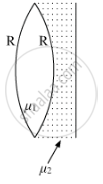Advertisements
Advertisements
Question
name the factors on which 'limit of resolution' depends ?
Solution
Limit of resolution depends upon the wavelength of the light used and the cone angle of light rays entering the microscope from the object.
APPEARS IN
RELATED QUESTIONS
A biconvex lens with its two faces of equal radius of curvature R is made of a transparent medium of refractive index μ1. It is kept in contact with a medium of refractive index μ2 as shown in the figure.

(a) Find the equivalent focal length of the combination.
(b) Obtain the condition when this combination acts as a diverging lens.
(c) Draw the ray diagram for the case μ1 > (μ2 + 1) / 2, when the object is kept far away from the lens. Point out the nature of the image formed by the system.
To increase the angular magnification of a simple microscope, one should increase ______.
A child has near point at 10 cm. What is the maximum angular magnification the child can have with a convex lens of focal length 10 cm?
The angular magnification of a system is less than one. Does it mean that the image formed is inverted?
A magnifying glass is a converging lens placed close to the eye. A farsighted person uses spectacles having converging lenses. Compare the functions of a converging lens used as a magnifying glass and as spectacles.
Why are the magnification properties of microscopes and telescopes defined in terms of the ratio of angles and not in terms of the ratio of sizes of objects and images?
A compound microscope has a magnifying power of 100 when the image is formed at infinity. The objective has a focal length of 0.5 cm and the tube length is 6.5 cm. Find the focal length of the eyepiece.
A person wears glasses of power − 2.5 D. Is the person farsighted or nearsighted? What is the far point of person without the glasses?
Magnification for spherical mirrors m is given by ______.
The focal length of the objective of a telescope is 60 cm. To obtain a magnification of 20, the focal length of the eye piece should be:
